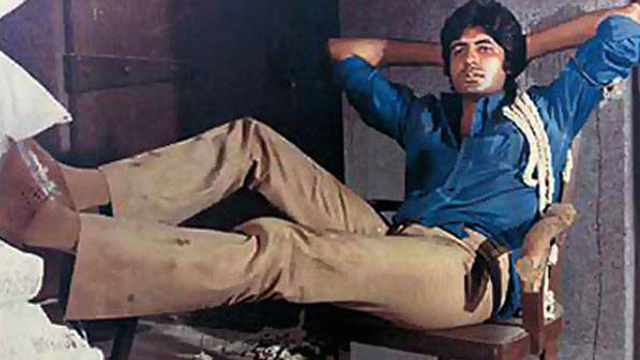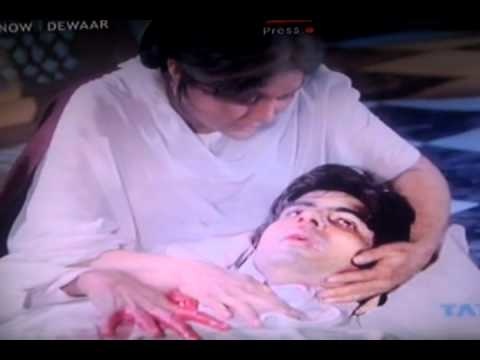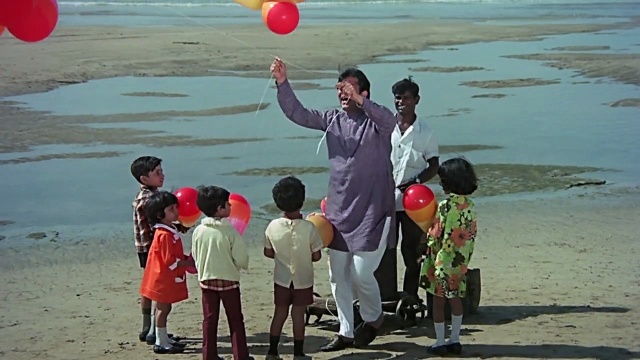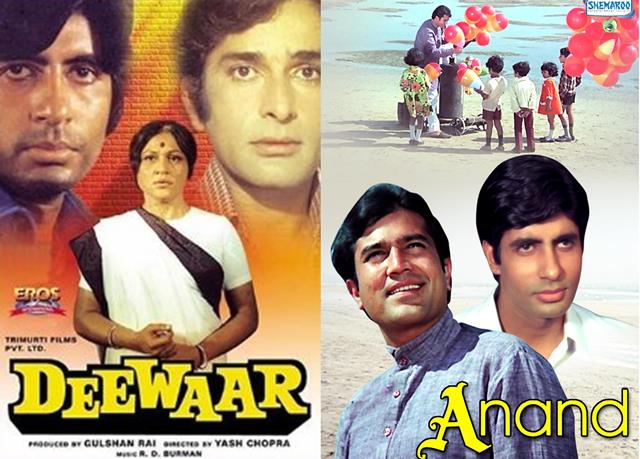In this article the author has engaged with two popular films of the 1970s- Anand and Deewar, and examined the philosophy of death that lies hidden in the symbolisms used I these two films.
Meenakshi Kulkarni, is a Theater Activist Based in Pune.
Many of us who are trained in cultural studies tend to devalue popular cinema because of our inclination to what is broadly seen as classical/art films. Even though much of popular Bollywood films are melodramatic and centred on predictable storylines with glamorous actors and actresses, it would however be wrong to say that there is no deeper structure or symbolic meaning and cultural values in these films. In this article I would refer to two super hit Hindi films which captured the imagination of people in the 1970s – Hrishikesh Mukherjee’s Anand(1971) and Yash Chopra’s Deewar(1975). What fascinates me about these two films is the story of death- death of the protagonists and the deeper meanings that these experiences of death conveyed. This is not my contention to argue that Hrishikesh Mukherjee or Yash Chopra were deliberately and consciously theorising death and depicting it in their films. However, what is important to note is that a cultural creator is often governed by unconscious civilizational archetypes. It is in this sense that death has acquired a nuanced meaning in these two popular films.
Before I come to the specificity of these two films, I wish to reflect very briefly on death. Yes, death is natural, an everyday phenomenon. Death is taking place all the time. Death is the disillusion of the physical body and one’s embodied existence. Despite its naturalness, death has always generated metaphysical wonder, spiritual longing and poetic revelation. It is in this sense that understanding death is not merely a matter of medical discourse. Each society, as cultural anthropologists argue, has its own notion of death- good death, meaningful death, undesirable death ,ugly death. Furthermore what does death imply? Is it the end of everything, is it a new beginning or is it a return to the original womb?
I believe that the two films I am referring to reveal something deep about the meaning of death, the context of death and the art of dying.
Hyper-Masculine Vijay and death in the mother’s lap
To begin with let me refer to Deewar- a film that possibly contributed a great deal to the construction of the image of the ‘angry young man’ associated with Amitabh Bachchan.

The film was a product of the turbulent 1970s – the growing disillusionment with the political system, the specter of unemployment and the discontent of the common folk. See the early childhood of Vijay in the film. His father – a trade union leader was forced to sign a document (because his wife and two children were kidnapped) that eventually betrayed the cause of the workers he was representing. This was the beginning of turmoil. His father was severely beaten up by the workers, hospitalised and utterly stigmatised. One day he disappeared. Vijay with his younger brother and mother grew up in that environment of utter helplessness, poverty, social marginalisation and psychic turmoil. Anyone who has seen the film carefully would feel the power of the visuals- Nirupa Roy with her two children walking through the Marine Drive, or Nirupa Roy as a construction worker experiencing humiliation and Vijay as a small child feeling this trauma through his bone and blood.
Vijay eventually grew up, Amitabh Bachchan took over. He joined as a coolie( porter) in the Bombay dock. His younger brother Shashi Kapoor- easy going and idealistic became a police inspector. A couple of powerful visuals in the film revealed the inner turmoil of Vijay- his anger, his extraordinary courage ,his daring spirit and his ability to fight the gangsters who used to exploit poor, ordinary porters in the dock. This aroused the attention of a rival gangster enacted by Iftekar . It was a turning point in Vijay’s life . He became part of a smuggling group ; materially he began to prosper; but his separation from his mother and younger brother became more and more intense. Nirupa Roy as a mother became almost like Krishna in the battlefield of Kurukshetra , Vijay’s younger brother Shashi Kapoor was given the responsibility to arrest him. Nirupa Roy told him: ‘It is dharma for you; and to fulfill your dharma even if you have to arrest and hurt your elder brother don’t step back’. Vijay was also an atheist; in fact a remarkable scene in the film indicated the two distinct paths that these two brothers took in life. While the younger brother with his mother entered the temple, the elder brother refused to bow down and took a different path.

Vijay’s psychic pain, despite his material prosperity, was killing him from inside; his separation from his mother was becoming unbearable. See the way the film took a turn; in the final encounter the younger brother’s bullet penetrated into Vijay’s body; yet he did not end his life , drove his vehicle like a restless soul in search of ultimate redemption, entered the temple, surrendered before his mothered and died in her laps. In terms of visual symbolism tormented Vijay , compassionate mother and the temple complex gave a deeper meaning to Vijay’s death. Birth, many psychoanalysts tell us, is the beginning of separation anxiety. One has come out of the protective shelter of mother’s womb, and it is also said that particularly for a male child some sort of a mother fixation always accompanies him. This fixation was obvious in the film. As he was realising the psychic and spiritual separation from his mother, his sense of sin and deviation was haunting him. No wonder, his last journey as an injured body with a tormented soul to the temple was a kind of pilgrimage. With his death in his mother’s lap he was salvaged. In a way, he returned to his mother’s womb, the ultimate shelter.
Death became sacred and a union.
Poetic Anand, death and final laughter
Hrishikesh Mukherjee’s Anand, as I see, was Rajesh Khanna’s finest film. Furthermore, with immense sensitivity, humanism and simplicity the director gave a new meaning to his film.Unless one understands and acknowledges death one does not live meaningfully. Life and death are not two separate entities. Death is not necessarily ugly. Its idea need not be repressed.

In this film Rajesh Khanna as Anand is suffering from Cancer. He knows the implications of this fatal disease. He also knows the way the detached science of biomedicine sees death, calculates the remaining time he has with him. He knows everything, and yet the more closer death comes to him the more he begins to live intensely, meaningfully. Never does he lose his laughter, his sense of humour. In fact, it is this lightness of being that surprises his friend Amitabh Bachchan who has acted as a doctor in the film. Bachchan is attached to him; from deep inside he feels pain. His intense gaze reveals this anxiety, but then Anand has that surplus that enables him to charm this Babumoshai. Possibly the finest moment in the film is expressed through a remarkably beautiful visual and song. The oceanic current of the sea has always attracted good filmmakers as an extraordinarily powerful metaphor. The sea is the infinite— flowing eternally without beginning or end. The waves as temporal entities emerge, touch the seashore and disappear. It captures the great spiritual meaning of the interplay of the temporal and the eternal. Like the waves we too with our embodied existence come and disappear. But what remains is the eternal flow of creation and its play like the movement of the ocean. Rajesh Khanna releases from his hands colourful balloons, walks through the seashore and sings a song. Its lyrics as well as the voice of Manna Dey take us to a different journey. We too realise that when waves disappear they become part of the sea again. They come from and disappear into the sea. Likewise, we too come from the same eternal energy and disappear into it. Through his disease and deep sensitivity and inner churning Anand realised it, and it enabled him to live every moment without any stigma, or the burden of a ‘sick role’. And he died meaningfully.
At the end of the film when suddenly the tape recorder begins to play and we hear Anand’s affectionate address to Babumoshai and his boundless laughter we feel that we are at the ghats of Varanasi where close friends and relatives are singing bhajans and kirtans, and someone close to them is taking his last breath with deep contentment and a sense of profound meaning of existence.
The New Leam has no external source of funding. For retaining its uniqueness, its high quality, its distinctive philosophy we wish to reduce the degree of dependence on corporate funding. We believe that if individuals like you come forward and SUPPORT THIS ENDEAVOR can make the magazine self-reliant in a very innovative way.









